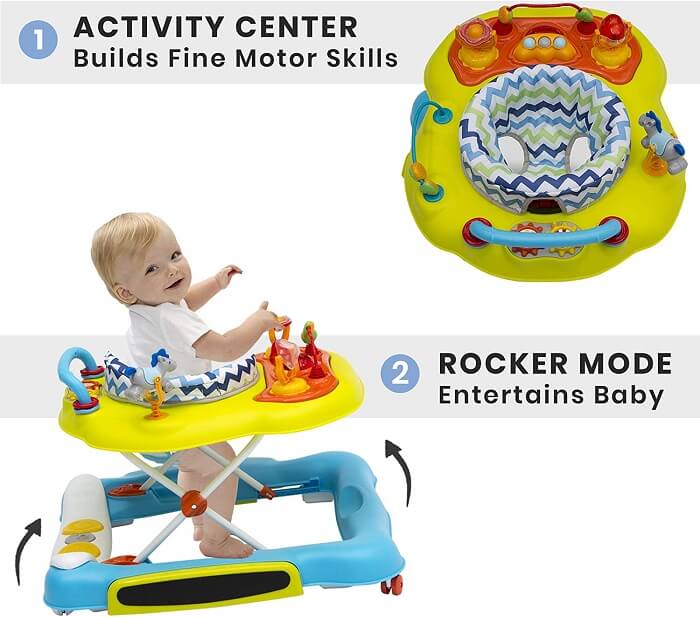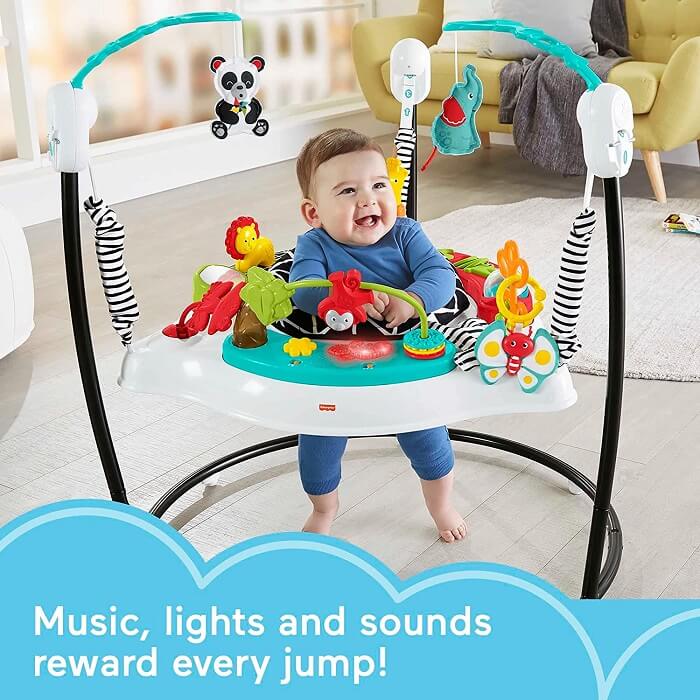Alternate Baby Walker Vs. Baby Jumper: The Ultimate Showdown for Your Little One’s Development
Choosing the right equipment for your baby's development can be a daunting task, especially when it comes to options like baby walkers and baby jumpers. Both these products aim to engage and entertain your little one while aiding their physical and cognitive growth. In this article, we will dive into the world of baby walkers and baby jumpers, exploring their features, benefits, and potential drawbacks. By the end, you'll be equipped with the knowledge to make an informed decision for your child's development journey.
What Is a Baby Walker?
A baby walker is a mobile device that allows babies to move around while seated in a suspended seat. Equipped with wheels or casters, it enables infants to propel themselves forward and explore their surroundings. Baby walkers often feature interactive toys and activities to entertain the child.
Baby Walker Pros and Cons
Advantages:
Enhanced mobility: Baby walkers provide a newfound sense of independence for infants, allowing them to move around and explore.
Entertainment and stimulation: Many baby walkers come with built-in toys, music, and interactive features, stimulating a child's senses and promoting cognitive development.
Encourages leg muscle strength: The pushing motion involved in using a baby walker can help strengthen leg muscles.
Disadvantages:
Safety concerns: Baby walkers can pose a safety risk, especially near stairs or uneven surfaces. Babies can move quickly and potentially topple over or access hazardous objects.
Delayed development: There is some evidence that excessive use of baby walkers may delay the
What Is a Baby Jumper?
A baby jumper is a suspended seat attached to an elastic cord or springs, allowing babies to bounce up and down while remaining stationary. It offers a different type of interactive play experience for infants, focusing on their leg strength and coordination.
Baby Jumper Pros and Cons
Advantages:
Physical exercise: Baby jumpers provide a fun way for babies to exercise their leg muscles and improve their coordination.
Sensory stimulation: Many baby jumpers come with attached toys, lights, and sounds, stimulating a child's senses and fostering cognitive development.
Hands-free moments: Using a baby jumper can give parents a brief period of hands-free time while the baby remains entertained and secure.
Disadvantages:
Restricted movement: Unlike baby walkers, jumpers keep infants in a stationary position, limiting their exploration of the surrounding environment.
Safety concerns: If not used properly or with appropriate supervision, babies in jumpers may tip over or collide with objects.
Safety Considerations
When it comes to baby equipment, safety should be the utmost priority. Both baby walkers and baby jumpers require careful attention to ensure a safe experience for your child.
For baby walkers, it's important to follow these safety guidelines:
- Choose a walker with a wide base for stability.
- Check for safety certifications and standards.
- Avoid using walkers near stairs, pools, or other potential hazards.
- Always supervise your child when they are in the walker.
- Adjust the walker's height to fit your baby comfortably.
- Regularly inspect the walker for any damage or wear.
- When using a baby jumper, consider the following safety precautions:
- Ensure that the jumper is securely suspended and properly installed.
- Use jumpers only on a flat and stable surface.
- Regularly inspect the jumper for signs of wear and tear.
- Avoid using jumpers near elevated surfaces or sharp objects.
- Limit the time your child spends in the jumper to avoid overstimulation.
Developmental Benefits
Both baby walkers and baby jumpers can offer certain developmental benefits for infants, although the emphasis may differ.
Baby walkers support development in the following ways:
- Motor skills development: Babies using walkers engage their leg muscles and practice coordination and balance.
- Cognitive development: Interactive features in walkers stimulate a child's cognitive abilities, such as cause-and-effect relationships and sensory exploration.
- Social and emotional development: The increased mobility provided by walkers allows babies to interact with their environment and potentially engage with others.
On the other hand, baby jumpers focus on:
- Motor skills development: Jumpers strengthen leg muscles and help infants develop their sense of balance and coordination.
- Cognitive development: Interactive toys and stimuli in jumpers promote cognitive growth, such as object recognition and spatial awareness.
- Social and emotional development: While jumpers limit mobility, babies can still enjoy visual and auditory stimulation, positively impacting their emotional well-being.
Which Option Is Right for Your Child?
Choosing between a baby walker and baby jumper depends on several factors, including your child's age, developmental stage, personal preferences, and individual needs. Consulting with a pediatrician can provide valuable guidance based on your child's specific circumstances.
For younger infants who have not yet developed sufficient head and neck control, it is generally recommended to avoid both walkers and jumpers. Instead, focus on activities that promote floor play, tummy time, and interaction with caregivers.
As your child grows and gains more stability, usually around 6 to 8 months, you can introduce a baby walker or baby jumper under careful supervision. However, remember that these devices should not substitute other essential activities for your child's development. They should be used in moderation and alongside other forms of play and interaction.
Consider your child's individual needs and preferences. Some babies may enjoy the freedom of movement provided by a walker, while others might prefer the bouncing sensation of a jumper. Observe how your child responds to each option and assess their comfort and enjoyment.
Remember that safety should always be a priority. Regularly inspect the equipment for any signs of damage or malfunction. Additionally, keep in mind that every child develops at their own pace, so it's essential to avoid pushing them into activities they might not be ready for.
Alternatives to Baby Walkers and Baby Jumpers
If you're uncertain about using baby walkers or baby jumpers, or if your child isn't quite ready for them, there are alternative options to promote their development:
Floor play: Encourage your child to explore and play on a safe and comfortable surface. Provide age-appropriate toys and engage in interactive activities together.
Tummy time: Allow your baby to spend supervised time on their stomach to strengthen their neck, back, and shoulder muscles. This helps with motor skill development and prepares them for crawling and eventually walking.
Exercisers and play mats: Look for age-appropriate exercisers or play mats that offer a variety of sensory experiences and encourage movement. These can include toys, mirrors, textures, and sounds to engage your child's senses.
By incorporating these alternatives into your child's daily routine, you can provide a diverse range of developmental experiences while ensuring their safety.
Tips for Safe Usage
Regardless of whether you choose a baby walker, baby jumper, or alternative options, it's crucial to follow these general safety tips:
Supervision and monitoring: Always supervise your child when they are using any type of equipment or engaging in play activities. Stay within arm's reach to prevent accidents and ensure their safety.
Proper usage guidelines: Read and follow the manufacturer's instructions for assembly, usage, and weight limits. Improper use can increase the risk of accidents and injuries.
Regular maintenance and inspection: Regularly check the equipment for any signs of wear, damage, or loose parts. Keep it clean and well-maintained to ensure its safety and longevity.
By implementing these safety measures, you can provide a secure environment for your child's play and exploration.
Conclusion
When it comes to choosing between a baby walker and a baby jumper, there is no definitive answer. Each option has its own benefits and considerations. It's essential to weigh the developmental advantages, safety concerns, and your child's individual needs.
Remember that these devices should supplement, not replace, other forms of play, interaction, and developmental activities. Always prioritize safety and ensure proper supervision. Consider alternative options if you're unsure about using walkers or jumpers, and consult with your child's pediatrician for personalized guidance.
By making informed decisions, you can create a nurturing environment that promotes your little one's growth, exploration, and happiness.
FAQs
Are baby walkers safe for my child's development?
Baby walkers can pose safety risks if not used properly or in certain environments. It's important to follow safety guidelines and provide proper supervision to ensure your child's well-being.
How long can a baby stay in a jumper?
It's recommended to limit the time spent in a baby jumper to 15-20 minutes per session, a few times a day. Extended or excessive use can lead to overstimulation or discomfort.
Can a baby walker hinder my child's ability to walk independently?
There is no conclusive evidence that baby walkers directly hinder a child's ability to walk independently. However, prolonged use of walkers without proper opportunities for natural exploration and development of motor skills may delay the natural progression of walking.
What age is appropriate to introduce a baby walker or baby jumper?
It is generally recommended to wait until your baby can sit upright unassisted and has good head and neck control before introducing a baby walker or jumper. This is typically around 6 to 8 months of age, but every child is different. Consult with your pediatrician for personalized advice.
Are there any specific brands or models you recommend?
The choice of brand or model for baby walkers or baby jumpers depends on individual preferences and safety features. Look for well-established brands that meet safety standards and have positive customer reviews. Always check for recalls or safety concerns before making a purchase.
Remember, your child's safety, comfort, and developmental needs should be the primary factors in selecting the right equipment. Keep them engaged, stimulated, and supported in their growth journey.!"




